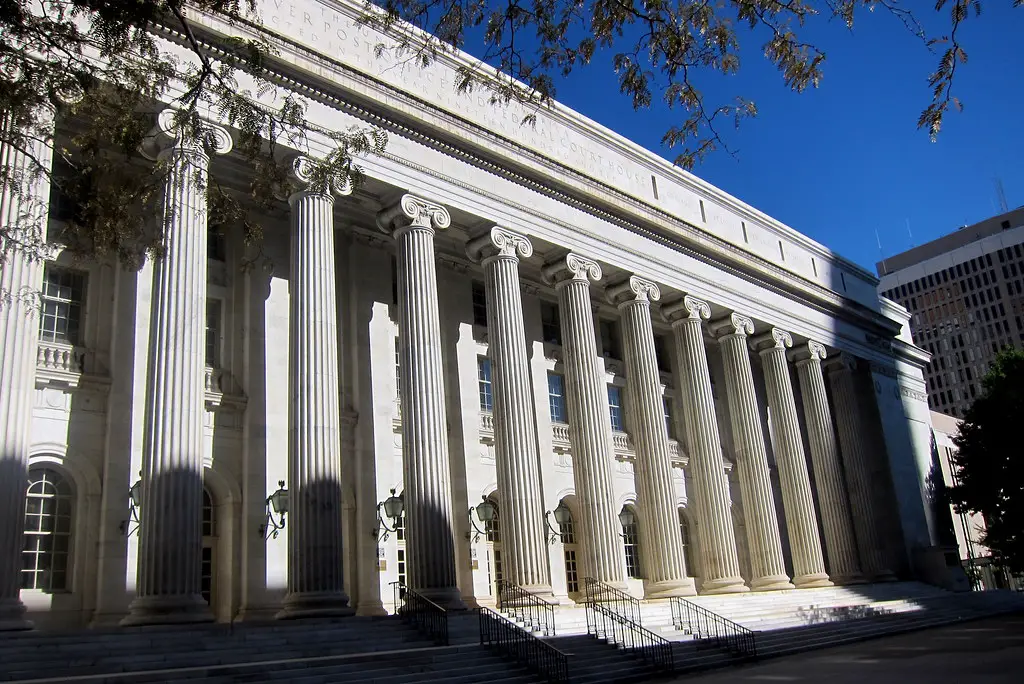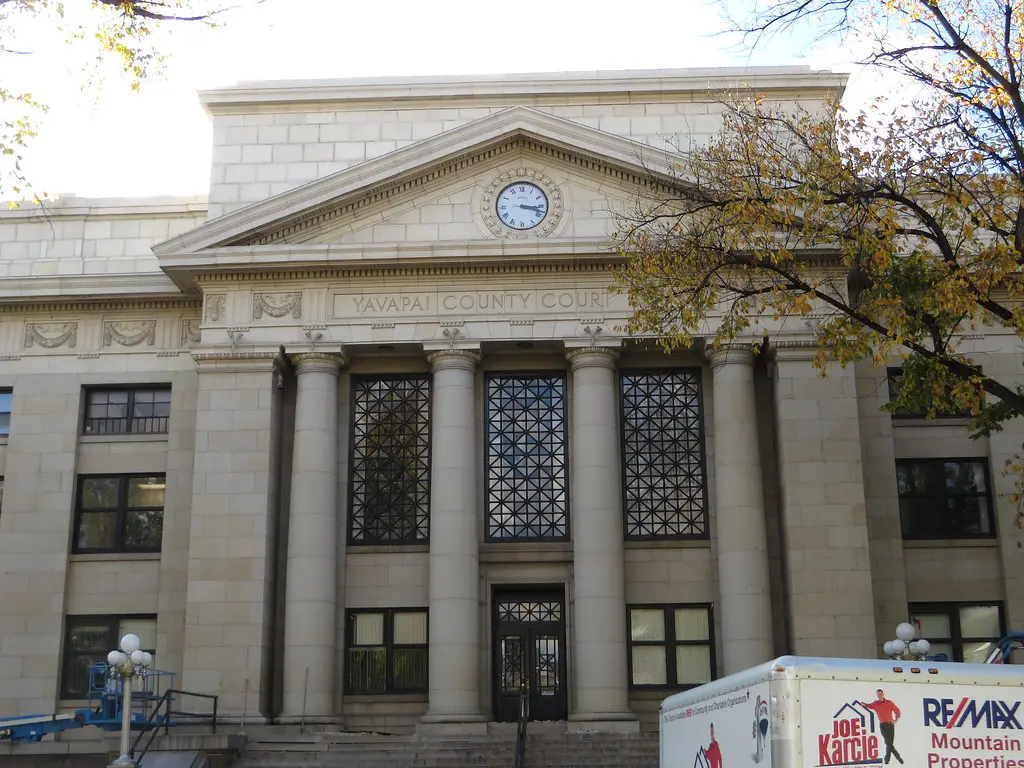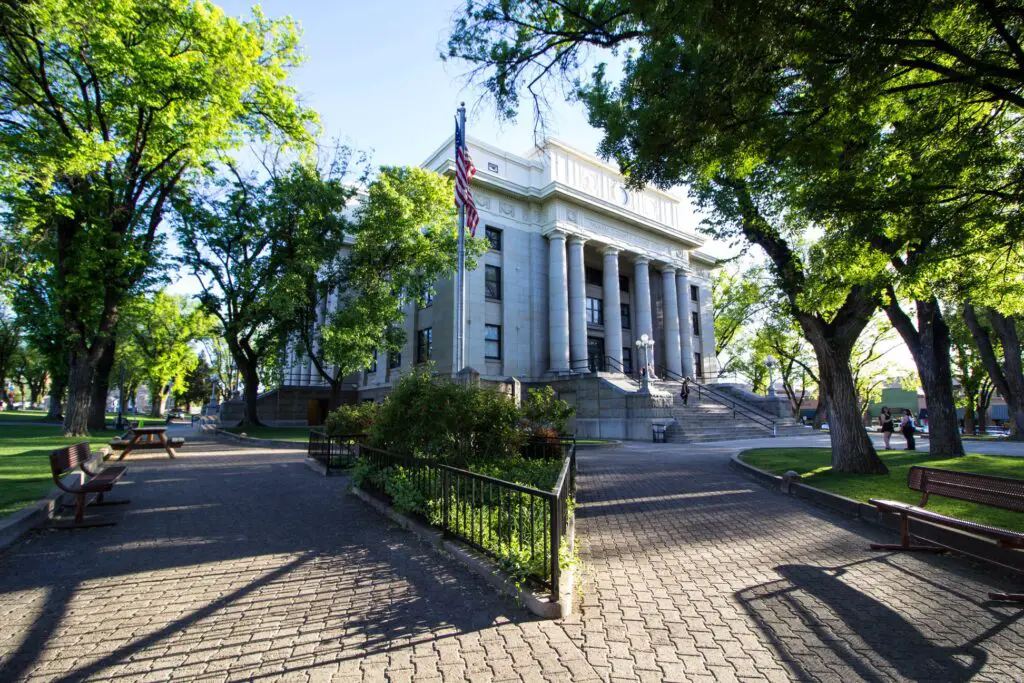The Yavapai County Courthouse is an important representative example of civic architecture in the style with decidedly Italian Renaissance antecedents. It originated from a June 1915 design competition that sought a Beaux Arts-styled structure possessing the most effective and impressive presentation. The courthouse’s architectural significance derives from the creative and innovative manner in which it adapts classical Beaux Arts architectural themes to regional materials and design elements. The highly successful design by Phoenix architects engendered further Arizona commissions for courthouses, banks, government buildings, high schools, and churches.
History of the Yavapai County Courthouse
The Yavapai County Courthouse has a rich history that dates back to the early days of Arizona’s territorial period. As Prescott became the seat of Yavapai County in 1864, the need for a proper courthouse became apparent.

Original 1878 Courthouse
Within a decade, Yavapai County required a larger facility, and a second courthouse was completed in 1878. This structure, designed by George Waters of Maine, occupied the Plaza lot designated for this purpose in the original town plat. In contrast to its modest predecessor, this building was a red brick structure with a Verde Valley sandstone ground floor, an elaborate portico, and a dome with clocks on each side. However, the building faced challenges, including a fire in 1892 and structural issues.
1916 Neoclassical Revival Building
Neoclassical Revival architecture of the 1916 to 1940 period was inspired by the architecture of the 1800s, in particular, that which drew upon the forms of the Greek Parthenon in Athens and gained bountiful status during the early republican years of the United States. Architectural expression was based upon a formal language reinterpreting the civic architecture of classical Greece and Republican Rome. This was a significant departure from the previous revival style of the Italian Renaissance that characterized so much of the late 1800s. Some of the early recognized masterpieces of Neoclassical Revival architecture included the West Virginia State Capitol, Jefferson Memorial, and the United States Supreme Court Building. The White House was idealized as the ultimate realization of the genre because of its illustrative detailing and majestic volume. Furthermore, the stylistic idiom generally was reserved for governmental and large important corporate edifices that made a public declaration of their presence.
Notable Historical Events
The Yavapai County Courthouse and its plaza have been at the center of numerous significant events. In 2000, presidential nominee George W. Bush visited the Prescott courthouse. In 2008, John McCain, another presidential nominee, made his only stop in his home state of Arizona at this historic site. The courthouse’s importance was further recognized when it was added to the National Register of Historic Places in 1977 and later listed as one of the Top 10 Public Places in America by the American Planning Association.
Architectural Features and Design

Neoclassical Revival Style Elements
The Neoclassical Revival style appeared at the end of the 19th century and the beginning of the 20th century in the context of the Neoclassical trend development known as Neoclassical Revival or Neo-Grec in Russia. From the mid-19th century, architects and artists based their classicism on the principal characteristics of Ancient Greek architecture. Seeking an outlet for the style and a possibility of new development, designers worked on new principles for its use in the 19th century. These principles are based on the vitality of created means. Classicism arises in a new light, offering a novel type of architectural and monumental style for all the national architecture of the Balkans and the eastern part of Europe in the 20th century. In Russia, the search for new foundations for the development of classicism took place in literature, architecture, and the arts. The trend was initiated by a two-rotunda palace design for Vladimir Alexandrovich in Sokolniki Park in the 1840s.
Italian Stonemasons and Local Granite
Granite occurs in nearly all of Italy. Consequently, the mineral became a traditional building stone in the differing areas of the nation. For centuries, the incursion into Italy of exceptional stonemasons of various nationalities skilled in the art of carving granite constitutes an important but still poorly studied chapter in the tale of the international availability of work in stone by émigré builders. This document the activities of a granite-carving company in Italy in the last quarter of the 19th century and the first decade of the 20th. It also reports on Italian stonemasons attracted to work with the company, namely Antonio Ghilarducci from Massa Carrara, and Giovanni Alippi, Rafael Menini, and Severino Gianneschi, then in Italy but born respectively in Bolle, Chiavenna, and Sondalo, all in Graubünden canton, Switzerland. It is divided into four sections. The introduction gives the reader an idea of the historical context of the study and is followed by the main text and a conclusion that sums up the reasons that led us to undertake the work.
Clock Tower and Bell
The courthouse’s clock tower is a defining feature of Prescott’s skyline. It houses an 800-pound bell, which was originally part of the old brick courthouse. This bell continues to be in use today, serving as a tangible link to the city’s past. The clock itself, delivered from the Howard Watch Co. in Boston, Massachusetts, adds to the tower’s functionality and historical significance. In 1908, braces were added to the clock tower to prevent it from swaying in the wind and causing the bell to ring unintentionally.
Exploring the Courthouse Plaza

The Yavapai County Courthouse Plaza serves as the heart of Prescott, Arizona, offering visitors a blend of history, art, and natural beauty. This vibrant public space influences the city’s cultural life and hosts numerous events throughout the year.
Statues and Monuments
The plaza features several notable sculptures that pay tribute to the area’s rich history. On the north side stands the Rough Rider Memorial, erected in 1907. This bronze equestrian statue, sculpted by Solon Hannibal Borglum, honors Arizonans who served in the Spanish-American War. It’s considered one of the finest equestrian sculptures in the United States. Another prominent statue is that of William “Buckey” O’Neill, a former Prescott mayor and Rough Rider, located in front of the courthouse. The plaza also houses the All-Veterans Memorial on the west side and the “Cowboy At Rest” statue on the south side, both adding to the historical ambiance.
Fountain and Bandstand
The plaza’s layout includes a historic bandstand, which predates the current courthouse. Built in 1895, this octagonal structure has been a focal point for community gatherings and performances. While the original 1910 fountain was removed, efforts have been made to restore the “Lady Ermintrude” statue, which was once part of it. These features contribute to the plaza’s charm and provide spaces for visitors to relax and enjoy the surroundings.
Trees and Landscaping
The courthouse plaza boasts an impressive urban forest, with over 170 trees gracing the grounds. Among these, 127 American elms create a lush canopy, offering shade and beauty. A notable addition is the Deodar Cedar, planted in 1910 to commemorate Arizona’s impending statehood. The landscaping includes expansive lawns edged by concrete curbs and cement walks, creating a park-like atmosphere in the heart of Prescott’s business district. This green oasis provides a perfect setting to explore the courthouse square events today or simply relax and soak in the historic ambiance.
Visitor Information and Nearby Attractions
Guided Tours
To explore the Yavapai County Courthouse and its surroundings, visitors can join walking tours of downtown Prescott. These tours offer insights into the city’s rich history and highlight the courthouse as a centerpiece. Tour guides are known for their extensive knowledge and ability to present historical facts engagingly. While internal tours of the courthouse may not be available, the exterior and plaza provide ample opportunities to appreciate its architectural beauty.
Special Events
The Yavapai County Courthouse Plaza hosts a variety of events throughout the year. From car shows to music festivals, and craft fairs to mountain bike events, there’s always something happening. Notable annual events include the Veterans Day Parade, the Summer Concert Series, and the Christmas Parade. The plaza also features seasonal activities, which visitors can find on the Events Calendar. These gatherings showcase the courthouse’s role as a community hub and offer visitors a chance to experience Prescott’s vibrant culture.
Whiskey Row and Downtown Prescott
Adjacent to the courthouse, Whiskey Row is Prescott’s most famous attraction. This historic street, known for its saloons and rich Wild West heritage, offers a unique glimpse into the city’s past. Visitors can explore eclectic shops, and art galleries, and enjoy live music at venues like Matt’s Longhorn Saloon and the Palace Restaurant and Saloon. The area around the courthouse square is dotted with restaurants, cafes, and bars, making it an ideal spot to explore Prescott’s local flavors and nightlife.
Today, the courthouse stands as the undisputed architectural center of the small city of Prescott, Arizona. It is located in the physical center of the downtown commercial core and occupies the corresponding architectural center position with its dominant mass and scale. The courthouse grounds stand as the always available city open space. The courthouse architecture is remembered and appreciated through local decorative schemes and signage. The building is the context within which downtown business people conduct their day-to-day endeavors and is considered the heart and soul of many of the city’s residents and visitors. The courthouse has framed the history, determined the architectural expectations, and solidified the economic base for the town for almost a century.


Leave a Comment
You must be logged in to post a comment.